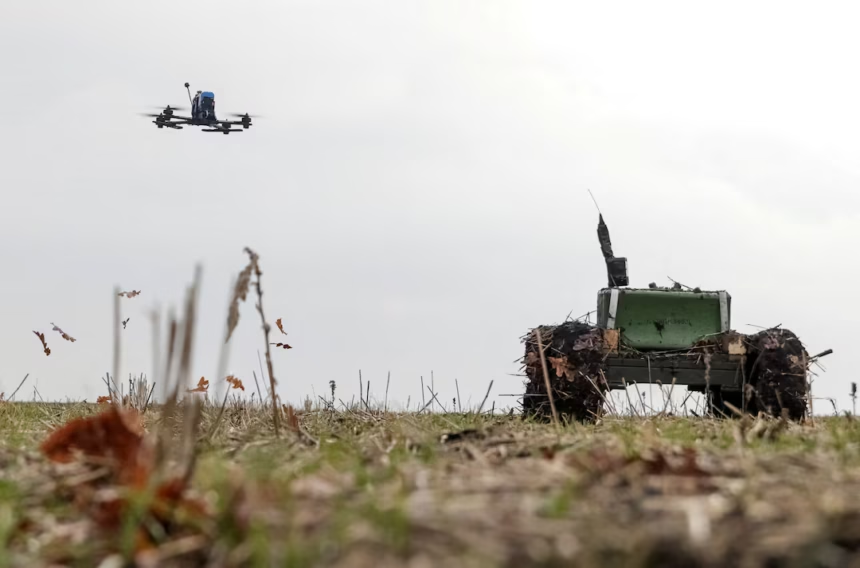The nature of warfare in Ukraine has been profoundly transformed by an unprecedented proliferation of drones, creating a deadly “kill zone” along the front lines that is significantly hindering Russia’s ability to exploit its traditional military advantages. This drone-intensive conflict is buying Ukraine critical time and enhancing its resilience, even amidst ongoing Russian advances.
“Drones, drones, drones. Only drones. A lot of drones,” a weary Ukrainian platoon commander, “Atom,” medically evacuated from the front, recounted, highlighting the machines’ omnipresence. These include kamikaze, surveillance, and bomber drones, as well as those designed to hunt other UAVs. Cheap, deadly, and deployed in vast numbers, drones are a primary reason Ukraine believes it can continue to resist advancing Russian forces this year and beyond, according to interviews with Ukrainian commanders, officials, and arms manufacturers.
The “Kill Zone” and Adapting Tactics
Ukrainian soldiers describe the approximately 10-kilometer (6.2-mile) corridor on either side of the line of contact as the “kill zone.” Remotely piloted unmanned aerial vehicles (UAVs) from both sides can swiftly spot and neutralize targets within this area. This evolution into the most drone-intensive conflict ever seen has eroded Russia’s ability to capitalize on its numerical superiority in troops, artillery, and tanks, as confirmed by two Ukrainian battlefield commanders.
Any large vehicle near the front is now an obvious target, preventing Russian forces from making the rapid, armored-column advances seen in 2022. “The enemy sees you completely,” added Oleksandr Dmitriev, founder of OCHI, a system centralizing video feeds from over 15,000 Ukrainian military drone crews. “No matter where you go or what you are driving.”
Consequently, Russian forces have adapted, typically attacking in small groups of five or six on foot, motorbikes, or quad bikes. This tactic aims to expose Ukrainian positions by drawing fire, subsequently allowing for drone strikes. The Russian defense ministry did not respond to requests for comment.
Despite these changes, Russian forces still maintain the ascendancy, making slow but steady advances in eastern and northern Ukraine. Military analysts note that Russia has caught up in UAV technology after an early lag, now producing millions of drones domestically each year, similar to Ukraine.
Ukraine’s Resilience and European Support
European leaders are currently trying to decipher U.S. President Donald Trump’s recent announcement that America would supply arms to Ukraine via NATO, with Europe bearing the cost. Details regarding the types and quantity of weapons, delivery timelines, and precise payment mechanisms remain unclear, according to U.S. and European officials.
White House spokeswoman Anna Kelly stated that the war had persisted too long, and Trump, seeking to end the killing, is facilitating U.S. arms sales to NATO for Ukraine while threatening substantial sanctions on Russia.
Individuals interviewed for this article, speaking before Trump’s weapons announcement, expressed belief that Ukraine could continue to fight and resist Russia even without further U.S. aid, though they did not provide specific timelines. Many cited the primacy of drones as having somewhat leveled the playing field, increasing Ukraine’s self-sufficiency, and also highlighted growing military supplies from European allies.
“We can hold out for months,” said Oleksandr Kamyshin, Ukrainian President Volodymyr Zelenskyy’s arms expert and strategic adviser, when asked about the cessation of U.S. weapon supplies. “In 2023 or 2024, it would have been a lot worse – we would be talking about days or weeks.”
Polish military analyst Konrad Muzyka, who has made numerous visits to the front lines, observed that Ukraine’s current focus is to deplete Russian attacks, as Kyiv currently lacks the capability to launch its own offensives. He cautioned that Ukraine would likely struggle in a long war of attrition due to manpower shortages and Russia’s superior resources. While drones have altered the battlefield, he advised against overstating their ability to fully compensate for a lack of artillery and mortars. “To deliver the amount of damage that an artillery shell does to a target, you would need to launch tens of drones,” he added. “Drones can fill in the gaps to some extent and give you some breathing space, but they are not a substitute for artillery.”
Drone Impact and Innovation
Drones are a pervasive threat in the 1,000 km (621 mile) line of contact. Reconnaissance UAVs, resembling miniature airplanes, spot enemies from several kilometers away, relaying real-time video. They guide fleets of bomber drones, often hexacopters the size of coffee tables that drop precision grenades, and kamikaze drones, some armed with RPG warheads, used to target soldiers, tanks, and weapon systems.
Ivan “Atom,” the evacuated platoon commander, noted that UAVs are now perceived as the greatest threat to soldiers’ lives on both sides, surpassing shells, mines, and enemy fighters that posed primary dangers earlier in the war. Olga Kozum, a 34-year-old medic, corroborated this, stating that most battlefield injuries she treats are caused by UAVs.
According to internal Ukrainian estimates seen by Reuters for 2024:
- 69% of strikes on Russian troops were conducted by drones.
- 75% of strikes on Russian vehicles and equipment were conducted by drones.
- About 18% of strikes on Russian infantry and 15% of strikes on vehicles and equipment were conducted with artillery.
- Even less were conducted with mortars.
The wartime UAV arms race has spurred numerous innovations. Both sides deploy short-range, fiber-optic drones resistant to electronic jamming, as well as “interceptors” designed to hunt down and destroy enemy drones.
Kyiv’s planned production of 30,000 long-range UAVs this year, designed to attack targets deep inside Russia such as arms depots and energy facilities, provides Ukraine with an increased offensive capability, according to Vadym Sukharevskyi, who commanded the country’s drone forces until early June. He stated that the average cost of a long-range strike drone ranges from $50,000 to $300,000, roughly 10 times less than a missile of similar range, though with a smaller warhead. “This is our asymmetrical answer,” Sukharevskyi said, adding that Ukraine developed such drones “precisely because we lack missiles.” Kamyshin added, “You can’t win a big war if you are only defending.”
Reliance on U.S. Air Defenses and Intelligence
Ukraine’s military-industrial base is expanding rapidly, now accounting for approximately 40% of the weapons and equipment used, including drones, according to Zelenskyy, who on Wednesday set a target to reach 50% in six months. Kyiv has also diversified its supplies, with European allies providing increasing amounts of munitions, enhancing Ukraine’s resilience to geopolitical shocks.
The Kiel Institute, a German-based economic research group, estimated in a report last month that Europe had surpassed the U.S. in total military aid provided for the first time since June 2022, reaching 72 billion euros compared with 65 billion euros from Washington. The institute noted a significant shift in aid flows in March and April due to no new U.S. aid allocation and increased European support.
While the U.S. remains the largest single supplier of artillery shells to Ukraine during the war, Europe is expanding its capacity and has procured hundreds of thousands of munitions from within and outside the continent. Of approximately 420,000 artillery shells received by Ukraine from the start of this year until mid-May, only 160,000 were from the United States, according to a European security source. Kamyshin stated that Ukraine produced around 2.4 million of its own shells in 2024, primarily for shorter-range mortars.
Nonetheless, Ukraine remains particularly reliant on the U.S. for air defenses and intelligence sharing. Kyiv especially covets U.S. Patriot air defense systems, capable of intercepting ballistic missiles frequently fired by Russia. As of April this year, Ukraine had only seven fully operational Patriot systems, significantly short of the 25 requested by Zelenskyy, according to analysts at Ukrainian publication Defence Express. Long-range drone and missile attacks often depend on U.S. satellite intelligence; the European Union Institute for Security Studies stated that European countries could only partially replace U.S. intelligence sharing if it ceased.







